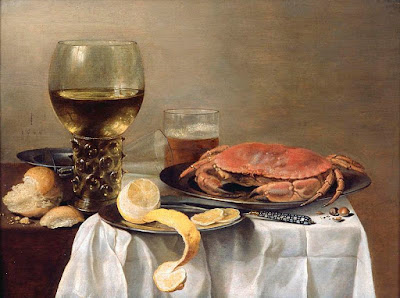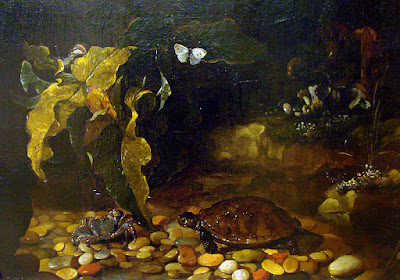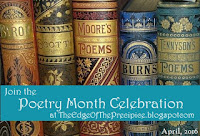For April Poetry Month, I’ve been hunting for a poem, a haiku that I wrote when I was fifteen to post here as a personal poetry selection. Well, so far I’ve had no luck finding it, but while searching I found a poem written by my daughter, modelled on the epic, Beowulf, so I thought I would post it instead. She wrote it in grade 5.
Since trying to follow the Anglo Saxon meter (which goes by stress-count [stressed syllables] rather than syllable count, which would be two main stresses in each half of a line) was beyond her at that time, instead she focussed on alliteration and kennings.
Kennings create expressive imagery, using compound words and phrases that identify nouns. They are often colourful to generate evocative images in the mind of the reader. Because of their usual quality, kennings help the listener/reader to remember important happenings or people and also were used to avoid superfluous repetition, making the poem more developed and creative.
And as to the answer to the riddle, you can find it in the following paintings:
 |
| Nature morte au crabe (1643) Pieter Claesz source Wikimedia Commons |
 |
| Breakfast with a Crab (1648) Willem Claeszoon Heda source Wikimedia Commons |
 |
| Still Life (1655-59) Pieter de Ring source Wikimedia Commons |
 |
| Tortue et crabe (c. 1656) Paolo Porpora source Wikimedia Commons |
 |
| Still Life with shrimps and crabs on a tin plate (1641) Alexander Adriaenssen source Wikimedia Commons |
 |
| Albrecht Dürer source Wikimedia Commons |




i'm mightily impressed with your daughter's poem: extraordinary work for a young person! many grownups would be proud to have created a poem like that. has she continued her work into adulthood? tx for sharing…
So good!
That is a wonderful poem! I'm so impressed! I had never heard of anglo Saxon meter or kennings. I really don't know much about the structure if poetry but I think it is a fascinating subject.
Thanks for your kind words, Mudpuddle. She's still in school, so she does write but now it's more serious compositions. I do try to encourage the more creative side of writing when there's time. We all need more leisure-time to be creative.
Thanks, Carol. It's nice to have something homeschool-ish somewhere else rather than just on a sheet of paper.
Thank you, Sharon! I wouldn't have known about kennings either if we hadn't studied Beowulf. I'd love to take a class on poetry but that will have to be when I'm less busy, so sadly not soon. I am enjoying this poetry month though. A great chance to read some poems that would otherwise have gone unread.
Very good! I'm glad your daughter learned to write poetry in school! I think it's a great way for kids to stretch their brain and play with words. Thanks to her for letting you share it with us!
She learned it from me (and a good program), as, like you, we homeschool.
It was funny …… when she read it again now, she said the ending made her feel very sad. Poor crabs! 😉
That was awesome!Very very good! You daughter is talented and I hope she keep exploring this creative side of her mind!
Thanks! I hope so too.
Did you notice that the pictures I found were all within about 15 years of each other? It was strange. I wonder if there was some trend on crabs with painters during this time and why? Odd. :-Z
hahhaaaaaa…no actually I did not! But let me google..it is very interesting!
All I can find is that still life was becoming very popular at this time. A crab was probably easy enough to make still and put on a platter. Perhaps they were challenging to paint? I don't know …… :-Z
Aha! I kind of thought you homeschooled, but couldn't remember for sure. What program were you using? I've used Kenneth Koch's book Wishes, Lies, and Dreams with my kids.
Poor crabs, destined to be dinner 🙁
I've used Classical Writing's Poetry for Beginners (they have two other levels that I'd like to use myself), and also Classic Academic Press's The Art of Poetry. Both complement each other well, but we really only had time to dabble and she came up with this one after reading Beowulf. I've also found the Centre for Lit online classes good for getting children reading, analyzing, and talking about it. See! So many good homeschool programs! I just love homeschooling! Now I'm off to check out Wishes, Lies and Dreams; I've never heard of it!
WOW! Your daughter is truly talented, I am so impressed. I really hope she keeps this up!
Also: crab legs are my favorite food, and we're going to go out to eat some this Sunday for my birthday. 🙂 So this poem came at an opportune time for me, haha!
Thanks! I'm going to google those three and bookmark them with the stuff I'll be looking over this summer while choosing my curriculum for next year.
Oooo, happy birthday to you!! I haven't had crab legs for awhile. I should take advantage of eating them more, since we live so close to the ocean. I have a feeling that the catches will be down this year because it is already unusually hot here and the crabs will then often go deep in search for cooler water. Smart little guys!
Thanks for the kind words about my daughter!
That’s got the kenning part down very well and is a pretty good riddle! What fun!
Boy, I miss homeschooling! I learned so much, lol!